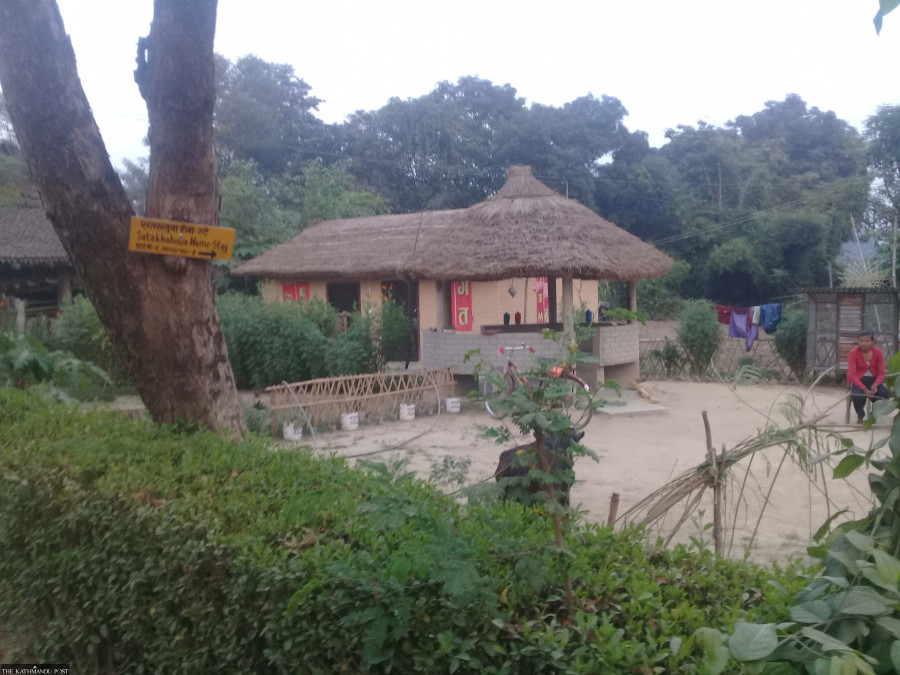Money
Dalla village in Bardiya is a homestay success story
Dalla features in the BBC’s list of top villages in the world that have made a socio-economic transformation.
Kamal Panthi
Dalla village in Bardiya district in western Nepal has earned the distinction of being a homestay success story and improving the living standard of the people in the process.
Homestay in the village, which has a 98 percent Tharu population, has produced observable social and economic impacts.
Dalla has also been included in the BBC’s list of top villages in the world that have made a socio-economic transformation.
The community homestay run by locals next to Bardiya National Park started to see more visitors despite making little marketing efforts.
Everything was going well until the Covid-19 pandemic hit the world in early 2020. But things are improving, and the number of domestic visitors has increased in recent days.
“The area has witnessed an increase in the number of domestic travellers after Covid cases started to drop,” said Parsu Chaudhary, chairman of Dalla Homestay.
The major wildlife attractions of the area are rhinos, tigers and elephants.
“The community forest is home to the rhino and the Bengal tiger,” said Chaudhary.
Locals have made a security team to patrol the area 24/7 to prevent poaching and theft of forest resources.
During the decade-long Maoist conflict, two rhinos and a tiger were killed in the community forest.
“People used to fear travelling to our village during the conflict,” said local resident Labaru Tharu. “Only a handful of visitors used to come to visit us. We lived in poverty, but now, our place is considered to be one of the most secure to live in and visit.”
The village consists of around 105 households. According to a study conducted by Nepal Rastra Bank, 22 Tharu households in Dalla village, who are basically engaged in agriculture, began their own homestay programme in March 2011.
The homestay depends largely on conservation activities in the nearby community forest in the Khata Corridor and Tharu culture. Tourists, especially those visiting Bardiya National Park, have been coming to Dalla.
The Khata Corridor is a narrow strip of forest that connects Bardiya National Park with India’s Katerniaghat Wildlife Sanctuary, providing wildlife such as tigers and rhinos the freedom to roam between the two countries.
About nine years ago, the Shiva Community Forest Group ran a job and skill development training programme with the aim of providing jobs to at least one member of each family. Since then, none of the villagers has left for employment, according to locals.
The forest is spread across an area of 103 hectares in the intermediate area between Bardiya National Park and local settlements.
Both men and women are engaged in occupations such as hair cutting, making dhakiya baskets from bamboo, eco-tourism, fish farming, poultry farming, beauty parlour, carpentry and masonry.
“Dalla is our first homestay in the Tarai that uses ecotourism as an approach to strengthen harmony between people and wildlife,” said World Wildlife Fund Nepal in 2016.
“The homestay programme initiated by us in the Khata Corridor in 2011 is helping local communities gain from conservation through ecotourism revenues of about $70,000 in the past five years.”
Dalla lies along the international bio trail. Visitors come to study and carry out research work on Dalla, which has been a model village near a national park in terms of human-wildlife harmony.
Dalla is situated about 30 km northwest of Gulariya, the headquarters of Bardiya district and just 4 km south of Bardiya National Park.
According to the latest tiger census, Bardiya is home to 125 tigers.
The visit to Dalla of Britain's then Prince Harry in March 2016 as part of his five-day Nepal visit rekindled the village’s fame in the international arena.
The village has been welcoming two to three dozen visitors, who are mostly from the neighbouring districts, daily.
Other celebrities to visit the area include Hollywood star Leonardo DiCaprio and Nepali actor Rajesh Hamal.
The visitors have been the only promoters of the village. Locals believe the place will see a surge in arrivals of foreign visitors if promoted effectively. The number of foreign visitors has declined after the Covid-19 pandemic, according to locals.
“The school enrolment rate in the village is 100 percent,” said Mangal Tharu, chairman of the community forest.
Locals have brought into operation a boarding school to impart quality education.
Sanitation is among the things that separates Dalla from its neighbouring villages. Dust bins have been kept at various places in the village to prevent littering and maintain cleanliness.
At present, 18 homestays are in operation at Dalle.
“The operation of homestays has contributed much to the tourism development of the area,” said Ram Shahi, who has been involved in forest conservation-related work for the past two decades.
Satakhaluwa Lake in Barbardiya Municipality-9, about 22 km north of Gulariya, has become a new destination for domestic visitors, especially picnic goers.
Homestays here offer a taste of Tharu cuisine. The local chicken curry is the trademark of Satakhaluwa.
Spread over an area of 60 bighas and formed by water from seven rivers, the lake is where animals come to drink water.
The lake contains fish, crocodiles and pythons, and holds a special significance for locals. There is also a temple in the middle of the lake.
To provide food and accommodation to visitors, nine private homestays have been in operation in the area since February 2017.
The lake is situated 3 km north of Baidi Chowk on the east-west highway.
“The area needs to be promoted among the tourists visiting Bardiya National Park,” said conservationist Sunil Chapagain. “A recent increase in visitors from neighbouring districts has motivated tourism entrepreneurs in the area.”




 8.12°C Kathmandu
8.12°C Kathmandu














